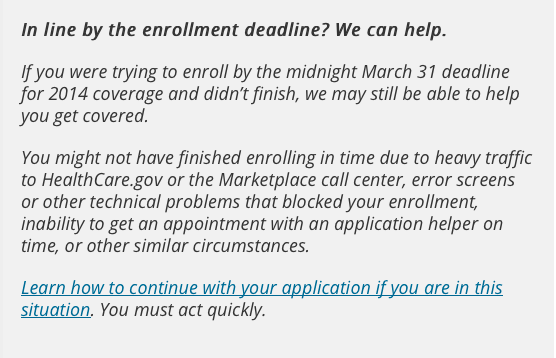
By Tricia Brooks, Georgetown University Center for Children and Families
Time for a victory lap over the announcement that marketplace enrollment whizzed past the revised target (that was lowered after the rocky launch) and exceeded the original projection of 7 million people? Not for navigators and certified application counselors who deserve much of the credit. They are still helping people swept up in the enrollment surge as the March 31st deadline neared, waiting for traffic to clear on log-jammed websites or “in line” literally at enrollment centers. Thankfully, HHS is allowing extra time for those who, through no fault of their own, have been unable to complete the process. So how does this work?
First, let’s clarify the different categories of special enrollment periods:
- “In-Line” SEP – people who started the application but were unable to finish due to system downtime, call volume or similar problems have until April 15 to complete the process.
- Limited Circumstance SEP for complex cases – people who encountered enrollment errors or specific system issues or received misinformation will have 60 days to enroll after the SEP is granted.
- SEP for Survivors of Domestic Violence – married individuals who have experienced domestic violence may also receive a limited circumstance SEP until May 31st.
- Qualifying life event SEP – people who have specific changes in circumstances such as the birth of a child or the loss of other minimum essential coverage may qualify for an SEP at any time outside open enrollment.
All state-based marketplaces and HealthCare.Gov are giving people who have taken steps to enroll but were unable to get through the process until April 15th to complete their applications. Consumers accessing coverage through the federal marketplace can go to “Enroll To-Do List” in their account and attest to to the fact that they were unable to enroll due to one of the reasons listed below. Or they may contact the call center saying they have tried to enroll and a customer service representative will read the same statement, to which the consumer must attest to verbally. They will then be able to complete their application and enrollment.

After the initial extension for people in line who faced enrollment delays, there still will be an opportunity for those who encountered more complex problems to enrollment if they meet specific circumstances (as described in the guidance). To receive approval, the consumer must call the call center and answer a variety of questions to determine if the consumer’s circumstances qualify for an SEP. If additional review is needed, the request will be referred to caseworkers. After the problem is resolved and an SEP granted, the consumer will have 60 days to enroll. These SEPs are generally intended to allow time for HealthCare.Gov to work through more complicated problems that occurred during open enrollment. Tips for assisters helping consumers with limited circumstance SEPs can be found here.
SEP for Victims of Domestic Violence
A recent clarification of policy has prompted a 60-day SEP, which is open until May 31, 2014, for an individual who is married, a survivor of domestic violence, living apart from a spouse, and unable to file a joint tax return. Such individuals should contact the call center to explain the situation to activate an SEP. Because the application has not yet been tailored to account for this circumstance, applicants are instructed by CMS to indicate NOT married on the application.
On an ongoing basis, outside open enrollment, there are a number of qualifying events that will trigger an SEP. Such events include loss of minimum essential coverage (MEC), marriage or the birth/adoption of a child, change in citizenship status or permanent move. People already enrolled in the marketplace may also qualify for an SEP if their qualified health plan violated a contract provision or they become newly eligible for premium tax credits or cost-sharing reductions. A qualifying event SEP can be activated through the “change in circumstance” functionality in my account on HealthCare.Gov. Generally, individuals have 60 days after the qualifying event to enroll.
If consumers feel they were erroneously denied an SEP, they have the right to appeal up to 90 days from the date their SEP is denied. Currently, the appeals process requires that a consumer complete a paper form and mail it in.
And don’t forget Medicaid and CHIP are open for business year round.
Editor’s Note: This post originally appeared on Georgetown University Center for Children and Families’ Say Ahhh! Blog.

